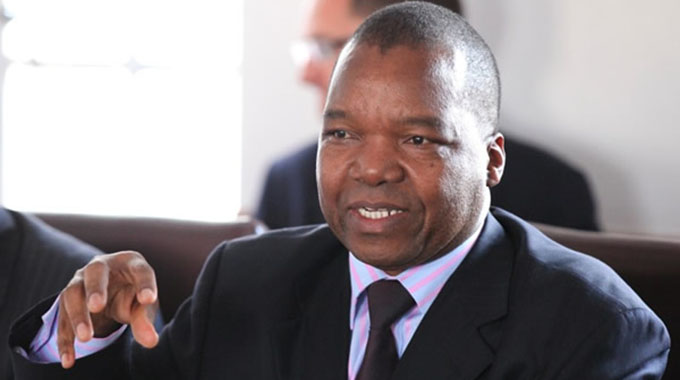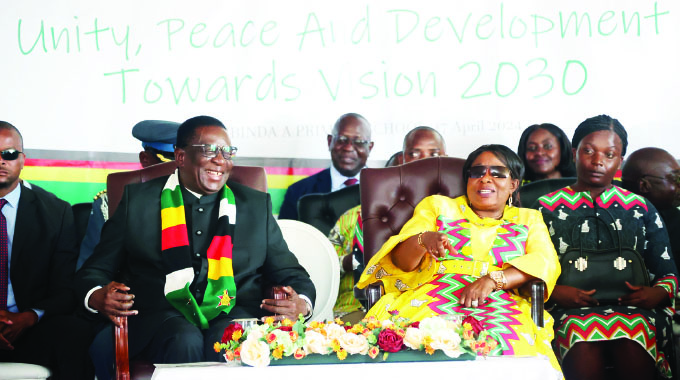Conducive environment boosts miners’ operations

Africa Moyo in VICTORIA FALLS
MINERS say the creation of a conducive operating environment has boosted their operations, with notable growth in sub-sectors such as gold, platinum, diamonds and platinum.
This came out during the official opening of the Chamber of Mines of Zimbabwe Annual Conference here, where President Mnangagwa was the guest of honour.
The conference, which ran under the theme, “Consolidating growth drivers for the mining industry”, attracted hundreds of mining executives, bankers and other professionals.
The President commended mining stakeholders for the rise in capacity utilisation in the sector where gold rose by 86 percent, diamonds 51 percent, coal 21 percent, lithium 83 percent, nickel 13 percent and platinum 13 percent in the first quarter of this year compared to the same period last year.
“This is highly commendable, well done to you all,” said the President.
The growth in the mining sector was realised despite the inadequate electricity supply that results in downtime at mines not connected to dedicated power lines, the impact of Covid-19 and other global shocks that have seen mixed fortunes in various sectors of the economy.
In his address, President Mnangagwa implored miners to expedite local value addition and beneficiation, invest heavily in improving infrastructure in areas they operate from, reclaim the pits they dig during extraction of minerals and support institutions of higher learning so that more fit-for-the-job graduates continue to be produced.

The President is flanked by Mines and Mining Development Minister Winston Chitando (second from left) and Matabeleland North Provincial Affairs and Devolution Minister Richard Moyo at the Zimbabwe Chamber of Mines annual conference in Victoria Falls yesterday
The President directed Zesa Holdings’ electricity distribution company, ZETDC, to provide electricity to new mining companies that have set up projects across the country.
This comes amid reports that over 20 mining projects, including three lithium mines, are still to be connected to the grid, and are therefore unable to operate.
“I want to tell Zesa that minerals are found in areas that do not have the grid and the grid must go where the minerals are,” said President Mnangagwa.
“The availability of power is one of the critical factors that drive mining sector growth, particularly as we gear the local mining industry towards moving up the mineral value chain.
“I am, therefore, glad to note that the private sector is complementing Government’s initiatives through Independent Power Producers’ projects in thermal, hydro and solar. It is also pleasing to note that there are also numerous upcoming power generation projects in Hwange, which will ensure greater utilisation of our abundant coal reserves.”
Mining executives say their sector presently requires 450MW, but with more projects coming up, demand could rise to 1 500MW in the near future.
At the moment, Zimbabwe is generating and importing a total of 1650MW, while demand is about 1 750MW, leaving a deficit of about 100MW.
President Mnangagwa said the Government will continue to “timeously” address bottlenecks encumbering investment through implementation of various macroeconomic policies and measures in support of business and the local industry.
“This includes availing fiscal incentives, roads rehabilitation and development, upgrading of airports, expansion of power generation capacity as well as dam construction, among others.
“In this spirit, just this week, my Government reviewed regulations that were negatively affecting the coal sub-sector.
“As a listening President, I invite stakeholders in mining to come forward with proposals that can vault your sector to greater success.”
President Mnangagwa urged mining companies to scale up the implementation of robust and forward-looking strategies for accelerated and sustained growth.
In this regard, he said, it was imperative for the mining and metals industry to take advantage of the rebounding commodity prices and other developments such as a boom in the construction sector, demand for steel globally, as well as rising need for lithium, among other minerals.
President Mnangagwa said investments and local productivity within the mining sector must be reflective of the broader global market trends.
He said growth in the mining sector will also be anchored on increased investments in new technologies and operations that are in line with the Government’s thrust on value addition and beneficiation.
“Gone are the days of exporting products in their raw form. Focus should now be on unlocking value from our rich mineral resource base for sustainable socio-economic development.
“However, beneficiation in mining cannot be achieved by a business-as-usual mindset. It requires the development of backward and forward industrial linkages within the mining sector, and across other sectors of the economy,” President Mnangagwa said.
Mining houses that have already invested in local value addition of minerals such as chrome, granite, gold, diamonds and coal, were praised by the President.
He said his Government was in “constant engagement” with the platinum group of metal producers to expedite the setting up of a precious metal refinery in the shortest possible time.
“As you do so, however, the importance of sustainable extraction of minerals in a manner that does not negatively impact communities and ecosystems cannot be overemphasised.
“It is my expectation that mining houses now begin to green their operations through responsible mining towards low carbon emissions and a sustainable mining sector.
“Further, the emerging environmental, social and governance thrust in the mining sector now demands that mining houses create real benefits for the communities in which they are operating,” the President said.
Over and above supporting livelihoods, President Mnangagwa said it was also necessary for the mining sector to increase investment in protecting the environment, while building long-term community resilience.
In line with that, the President called for capacity building for mining sector professionals in environmental, social and governance matters.
He exhorted the Ministry of Mines and Mining Development and the Environmental Management Agency to ensure that mining houses abide by their commitments in their environmental impact assessments.
In addition, President Mnangagwa called on the mining sector to be a “model employer” by rewarding employees at “favourable levels”.
“As you grow and develop, employees within the mining sector must not be left behind,” he said.
To foster increased development in the mining sector, President Mnangagwa said the Government will continue to make necessary investments in infrastructure development.
The Government is ready to welcome private sector participation, including mining houses, in providing infrastructure.
The mining sector has been urged to leverage on the Second Republic’s remodelled education and training pathway, Education 5.0, which was informed by the national skills gap.
President Mnangagwa said such a development would in-turn ensure the nurturing of skilled professionals and artisans to feed into the country’s development trajectory.
“I, therefore, call upon the mining sector to partner with our institutions of higher learning and professional associations to guarantee development of a sustainable future talent pipeline, with the relevant mining sector skills.
“I also challenge the sector to take advantage of the ongoing Fourth Industrial Revolution to automate and digitalise for more targeted and efficient mining operations, while at the same time re-skilling and multi-skilling its workforce. Such investments must ultimately ensure the use of technological and innovation advancements such as artificial intelligence and associated solutions, across our mining value chains.
“As these skills are being developed, I urge the sector to remain alive to the importance of inclusivity as well as perspectives and priorities of both women and youth in mining,” said President Mnangagwa.
Mines and Mining Development Minister, Winston Chitando, said the growth in the sector was largely because investors had heeded President Mnangagwa’s ‘Zim is open Business’ mantra.
He said at the moment, almost every mining company is either expanding or planning to expand or has expanded its operations already.
“I thank you for heeding the call by the President to invest in Zimbabwe,” he said.
Minister Chitando added that by 2025, Zimbabwe will be processing base metals locally as the miners were actively working the process.
He added that the coal sector, which produced about 280 000 tonnes in 2017, is expected to produce over 2 million tonnes by the end of next year and 5 million tonnes by 2025.
Minister Chitando said the journey towards the US$12 billion mining industry by next year was irreversible as Zimbabwe seeks to achieve an upper middle income society by 2030.
Chamber of Mines of Zimbabwe president Mr Colin Chibafa commended the Government for creating “an enabling and conducive environment that has seen a number of positive developments in the mining industry”.
The developments have culminated in the commissioning of new mines across key sectors of gold, coal and lithium, among other key sub-sectors of the mining industry.
“Your Excellency, we are happy that you have been commissioning some of these projects, demonstrating your unwavering commitment to ensure that the mining industry maximises its contribution to the socio-economic development of the country.
“Two examples that come into mind are the recent commissioning of the Eureka Gold Mine and the Riozim BIOX Plant. With these and other projects firmly being part of the Zimbabwean mining landscape, we are convinced that the US$12 billion vision is on course.
“The spin-offs that come with this growth are huge as the country’s other sectors and economy in general stand to benefit from the massive expansion of the mining industry. Indeed the ‘Zimbabwe is Open for Business’ mantra that the Second Republic espoused is bearing fruits that no one can deny,” Mr Chibafa said.
The Chamber of Mines, he said, was gratified that the National Development Strategy clearly recognises the role that the mining industry is expected to play in transforming Zimbabwe into an upper middle-income economy by 2030.
“We note the responsibility placed on the mining industry in the realisation of the 2030 vision and our support of the mining vision of a US$12 billion mining industry by 2023 is assured.
“The Chamber of Mines of Zimbabwe remains committed to supporting Government policy, as it has always done, and we will continue to offer our considered advice to Government on matters that we are experts in for the country to fulfill its true potential.
“We are further encouraged by the efforts of Government to stabilise the macro-economic environment, promote the use of the Zimbabwe dollar and instill market discipline. We thank you, Your Excellency, for the measures you announced on 7 May 2022, which are bringing about convergence of the interbank and the auction market rates resulting in restoration of the value of the surrender portion of export proceeds. We are convinced that the measures will go a long way in fostering macroeconomic stability, a precursor to sustainable economic growth and development,” said Mr Chibafa.
He also saluted the President for the position adopted by the Government to suspend the beneficiation tax in line with progress achieved by the platinum group metals producers on the matter, pending finalisation of consultations with a view of further deferment.
“We are happy to report key milestones on the matter, with two of the current producers having set up smelting facilities and there is commitment to invest in a Base Metal Refinery and subsequently a Precious Metal Refinery. The Mining industry remains supportive and committed to the Government’s thrust of accelerated beneficiation of the country’s mineral resources,” said Mr Chibafa.
The mining sector rebounded by 3,4 percent in 2021 from a contraction of -9 percent in 2020, with the recovery largely driven by growth in gold that rose by over 50 percent and diamond sector by 58 percent.
The sector generated a record US$5,2 billion in export earnings last year, representing 83 percent of national exports, compared to US$3,7 billion in 2020. This year, the sector is projected to grow by 8 percent, benefitting from favourable commodity prices and production ramp up across key minerals.
However, Mr Chibafa lamented foreign currency shortfalls, capital constraints, electricity outages and high cost of production.







Comments